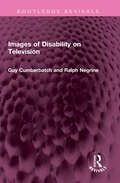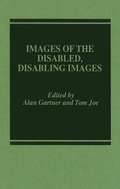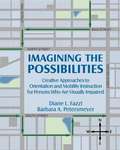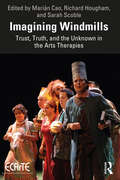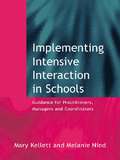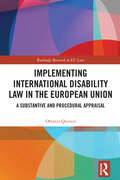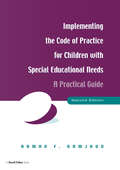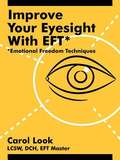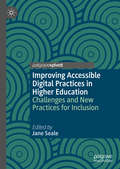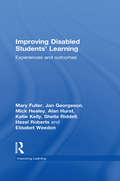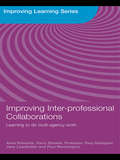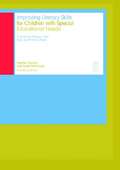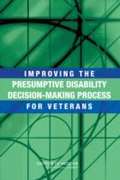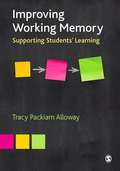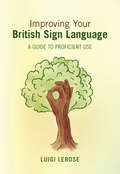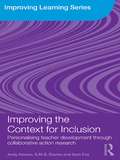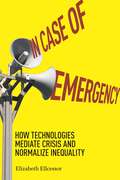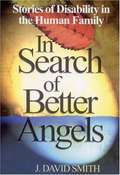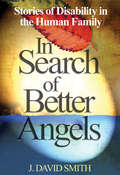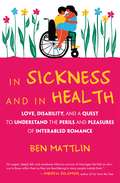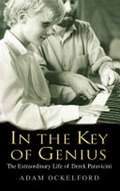- Table View
- List View
Images of Disability on Television (Routledge Revivals)
by Guy Cumberbatch Ralph NegrineFirst published in 1992, Images of Disability on Television examines the frequency and nature of disability on British and American television and how it is perceived and presented by programme makers. Attitudes held by those closest to the issues – disabled people, their carers, and television producers and writers – are presented as the result of interviews and discussions. There is an increasingly strong sentiment that television has got it wrong as far as disability is concerned and does not play its proper role in allowing the non-disabled to understand fully the world of disabled people. This book provides information to promote greater understanding of the needs of the disabled people in television portrayal and opens up possibilities for a change in attitudes. It will be valuable reading for students, researchers and lecturers in the social sciences, communication studies, and media studies.
Images of the Disabled, Disabling Images
by Alan Gartner Tom JoeIn this collection of a dozen essays, writers with strong backgrounds in the disability rights movement examine the roots of public attitudes toward the disabled. Several essays consider portrayals of people with disabilities in literature, film, and journalism. Others explore social policy toward the disabled in education, employment, and health-care. Nat Hentoff's powerful piece, ""The Awful Privacy of Baby Doe," expresses the author's outrage over the case of a child born with spina bifida who was denied treatment because doctors persuaded her parents that she would be better off dead.
Imagining Autism
by Sonya Freeman LoftisA disorder that is only just beginning to find a place in disability studies and activism, autism remains in large part a mystery, giving rise to both fear and fascination. Sonya Freeman Loftis's groundbreaking study examines literary representations of autism or autistic behavior to discover what impact they have had on cultural stereotypes, autistic culture, and the identity politics of autism. Imagining Autism looks at fictional characters (and an author or two) widely understood as autistic, ranging from Conan Doyle's Sherlock Holmes and Harper Lee's Boo Radley to Mark Haddon's boy detective Christopher Boone and Steig Larsson's Lisbeth Salander. The silent figure trapped inside himself, the savant made famous by his other-worldly intellect, the brilliant detective linked to the criminal mastermind by their common neurology--these characters become protean symbols, stand-ins for the chaotic forces of inspiration, contagion, and disorder. They are also part of the imagined lives of the autistic, argues Loftis, sometimes for good, sometimes threatening to undermine self-identity and the activism of the autistic community.
Imagining The Possibilities
by Diane L. Fazzi Barbara PetersmeyerThis book explores creative methods of teaching various orientation and mobility techniques to persons who are blind or visually impaired, including those with multiple disabilities. Imagining the Possibilities is a hands-on teaching resource for pre-service and practicing O&M specialists. It offers materials, samples, and creative teaching strategies for working effectively with students.
Imagining Windmills: Trust, Truth, and the Unknown in the Arts Therapies
by Richard Hougham Sarah Scoble Marián CaoImagining Windmills presents a compilation of scholarly chapters by selected authors of global standing in the arts therapies. This book reflects the theme of the 15th International Conference of the European Consortium for Arts Therapies (ECArTE), held in Alcalá de Henares, Spain, birthplace of Miguel de Cervantes. This innovative work seeks to further understanding of arts therapy education, practice and research and incorporates current thinking from art therapists, dance-movement therapists, dramatherapists and music therapists. Writers from Belgium, Germany, Greece, India, Israel, Italy, The Netherlands, Spain, Sweden, UK and USA combine to give an international voice to the book, which celebrates cultural distinctiveness, while also presenting shared intercultural developments in the professions. This interdisciplinary publication explores questions of the unknown and the imagined, misconception, delusion, truth and trust in the arts therapies. It enquires into ways in which education and the practice of the arts therapies engage with the imagination as a place of multiple realities, which may lead us closer to finding our truth. This book will be of interest and relevance not only to those in the arts therapeutic community, but also to a broad audience including those in related professions – for instance psychology, sociology, the arts, medicine, health and wellbeing and education.
Imperative for Inclusion: A Passionate Plea
by Nir Shrestha"Imperative for Inclusion: A Passionate Plea" by Nir Shrestha explores the challenges and opportunities for disability inclusion in Nepal. The book delves into the legal and governance frameworks established by the 2015 Nepalese Constitution, highlighting the gaps between policy and practice in areas such as education, healthcare, and independent living. Shrestha emphasizes the need for effective advocacy, long-term planning, and active participation of persons with disabilities in governance. He shares personal experiences to illustrate the barriers faced in education and calls for improved resource allocation and teacher training. The book also addresses the importance of digital accessibility and the societal attitudes that hinder disability inclusion. Shrestha advocates for comprehensive support systems, including personal assistance and community support, to ensure independent living and resilience in disaster scenarios. Through a mix of personal narratives and policy analysis, the book underscores the necessity of transforming disability inclusion from aspiration to reality.
Implementing Intensive Interaction in Schools: Guidance for Practitioners, Managers and Co-ordinators
by Mary Kellett Melanie NindFirst Published in 2003. Routledge is an imprint of Taylor & Francis, an informa company.
Implementing International Disability Law in the European Union: A Substantive and Procedural Appraisal (Routledge Research in EU Law)
by Ottavio QuiricoThis book investigates the implementation of disability rights and duties in the European Union, aiming to understand its functioning and explore ways forward through a critical analysis of the Convention on the Rights of Persons with Disabilities (CRPD) within the context of international regulation. Along the lines of the integration of fundamental rights within the common market, the EU has indeed progressively adopted meaningful regulation to advance disability rights, which are now essentially shaped by the CRPD. The research considers the interaction between law and policy at the international, EU and Member States’ level, focusing on three essential elements, including the sources of disability law, institutional mechanisms and substantive regulation. Grounded in the distinction between primary rules on law-making and secondary norms on enforcement, the analysis unfolds against the background of the ‘twin’ transitions on sustainability and digitalisation and encompasses the Council of Europe system, particularly in the light of the foreseeable accession of the EU to the European Convention on Human Rights. Arguably, following the progressive development it has facilitated in other regulatory areas, the Court of Justice of the European Union can provide a decisive contribution to advancing inclusiveness for people with disabilities in the Union.The book is a useful resource for practitioners, policymakers, academics, students, researchers and anyone interested in EU and international disability law and politics.
Implementing Systematic Interventions: A Guide for Secondary School Teams
by Hank Bohanon Lisa Caputo Love Kelly MorrisseyAccessibly written and specifically designed for secondary schools, Implementing Systematic Interventions provides you with the tools you need to successfully organize for and smoothly implement schoolwide intervention strategies. Discover how to: • Organize administrative support and leadership teams; • Create effective communication techniques and protocols; • Use effective models to select school-specific priorities; • Support staff and students during the transition; • Identify desired outcomes and assess whether or not they've been achieved. Featuring supplemental online resources, this essential guide helps your team avoid common mistakes, identify clear goals, and implement successful interventions to help every student succeed.
Implementing the Code of Practice for Children with Special Educational Needs: A Practical Guide
by Ahmad F. RamjhunThis new edition has been revised to bring teachers and other education practitioners up to date with the revisions to the Code of Practice due to come into force in January 2002. The author was a member of a working party for the National Advisory Group for special educational needs, with a remit to assist with the revision of the Code. This book reports on the outcomes, and details advice and guidance on the key tasks for its effective implementation.
Improve Your Eyesight with Eft*: *Emotional Freedom Techniques
by Carol LookBased on an experiment conducted by EFT Master, Carol Look, "Improve Your Eyesight with EFT" invites you to improve your vision by releasing pent up emotions stored in your eyes. Emotions such as fear, guilt, anger and shame show up in every other part of our anatomy and physiology, why not in our eyesight? Considering that few doctors or lay people even entertain the idea that our eyesight could be improved by balancing our energy system with a simple method such as Emotional Freedom Techniques (EFT), the final results of the experiment were nothing short of fantastic. Approximately 75% of participants reported between a 15-75% improvement in their vision. . just from tapping on acupressure points while focusing on their emotions! EFT is the ideal tool to address emotional blocks that have been preventing you from seeing clearly.
Improving Accessible Digital Practices in Higher Education: Challenges and New Practices for Inclusion
by Jane SealeThis book examines the role played by technologies in removing the disadvantage experienced by students with disabilities in higher education. Addressing five key themes, the editor and contributors explore the practices required of stakeholders within higher education institutions to mediate successful and supportive relationships between disabled learners and their technologies. Ultimately, the book argues that practice in the fields of disability, ICT and higher education is still not providing consistent and widespread positive learning experiences to students with disabilities. In order to address this situation, the field needs to creatively integrate knowledge gained through both research and practice, and to re-imagine what is needed for ICT to meaningfully contribute to a reduction in disadvantage for disabled students. This book will be of interest and value to scholars of disability studies, education and accessibility, and educational technologies.
Improving Disabled Students' Learning: Experiences and Outcomes (Improving Learning)
by Alan Hurst Sheila Riddell Hazel Roberts Elisabet Weedon Jan Georgeson Mary Fuller Mick Healey Katie KellyHow do disabled students feel about their time at university? What practices and policies work and what challenges do they encounter? How do they view staff and those providing learning support? This book sets out to show how disabled students experience university life today. The current generation of students is the first to move through university after the enactment of the Disability Discrimination Act, which placed responsibility on universities to create an inclusive environment for disabled students. The research on which the book is based focuses on a selected group of students with a variety of impairments, as they progress through their degree courses. On the way they encounter different styles of teaching and approaches to learning and assessment. The diversity of their views is reflected in the issues they raise: negotiating identities, dealing with transitions, encountering divergent and sometimes confusing teaching and assessment. Improving Disabled Students’ Learning goes on to ask university staff how they experience these new demands to widen participation and create more inclusive learning climates. It explores their perspectives on their roles in a changing university sector. Offering insights into the workings of universities, as seen by their central participants, its findings will be of great interest to all practitioners who teach and support disabled students, as well as campaigners for an end to discrimination. Crucially, it foregrounds the views of disabled students themselves, giving rise to a complex, contradictory and always fascinating picture of university life from students whose voices are not always heard.
Improving Inter-professional Collaborations: Multi-Agency Working for Children's Wellbeing (Improving Learning)
by Anne Edwards Harry Daniels Jane Leadbetter Tony Gallagher Paul Warmington** Shortlisted for the NASEN Special Educational Needs Academic Book Award 2009 ** Inter-professional collaborations are invaluable relationships which can prevent the social exclusion of children and young people and are now a common feature of welfare policies worldwide. Drawing on a four year study of the skills and understanding required of practitioners in order to establish the most effective interagency collaborations, this comprehensive text Gives examples from practitioners developing inter-professional practices allow readers to reflect on their relevance for their own work Emphasises what needs to be learnt for responsive inter-professional work and how that learning can be promoted Examines how professional and organisational learning are intertwined Suggests how organisations can provide conditions to support the enhanced forms of professional practices revealed in the study Reveals the professional motives driving the practices as well as how they are founded and sustained Full of ideas to help shape collaborative inter-professional practice this book shows that specialist expertise is distributed across local networks. The reader is encouraged to develop the capacity to recognise the expertise of others and to negotiate theor work with others. This book is essential reading for practitioners in education and educational psychology or social work, and offers crucial insights for local strategists and those involved in professional development work. The book also has a great deal to offer researchers working in the area of cultural historical activity theory (CHAT). The four year study was framed by CHAT and offers a well-worked example of how CHAT can be used to reveal sense-making in new practices and the organizational implications of enhanced professional decision-making. As well as being important contributors to the developing CHAT field, the five authors have worked in the area of social exclusion and professional learning for several years and have brought inter-disciplinary strengths to this account of inter-professional work.
Improving Literacy Skills for Children with Special Educational Needs: A Guide To Helping In The Early And Primary Years
by Sarah Parkhouse Heather DuncanThis practical book, written by experienced practitioners, will help teachers of pupils with Special Educational Needs assess, record and improve the literacy skills of their pupils. The creation of the National Literacy Strategy and the Literacy Hour has put additional demands upon teachers, particularly those concerned with Special Needs.The book covers all aspects of literacy development through the Early and Primary Years including early skills, reading, phonological skills, writing, spelling and handwriting. This resource pack includes advice and ideas on record keeping with Individual Education Plans, assessing pupils' skills and strategies for future learning.It contains photocopiable checklists and assessment sheets for both teacher and pupil to complete and has clear child-friendly illustrated worksheets throughout. An indispensable resource for all classrooms.
Improving The Presumptive Disability Decision-making Process For Veterans
by Institute of Medicine of the National AcademiesProduced by a committee of the Institute of Medicine, this report describes the current decision-making process for the provision of appropriate health care and disability compensation for veterans with health conditions that develop after military service which, in the absence of scientific evidence to create a complete link, are presumed to be connected to their military service. The report contains a brief history of presumptive disability decisions, description of the decision-making process, legislative background on presumptions, and evaluations of selected case studies of specific exposures and illnesses, and proposes a revised framework for building stronger scientific evidence into the process for making presumptive decisions in the future. The 13 appendices contain information organized by the Committee and Institute of Medicine to assist readers in understanding the background and issues; three of the appendices are in the book and ten are on an accompanying CD-ROM. No subject index. Annotation ©2009 Book News, Inc. , Portland, OR (booknews. com)
Improving Working Memory
by Tracy Packiam AllowayYour working memory is the information your brain stores for a short period of time, it is your brain's post-it note if you like, and how much information you can remember has a huge influence on how well you do at school, and beyond. By understanding a child's working memory, you will be able to support their learning at school, and their concentration. Better working memory can be particularly useful to children with conditions where poor working memory is thought to be an underlying factor. Such conditions include: - dyslexia - dyscalculia - speech and language difficulties - developmental coordination disorders (motor dyspraxia) - ADHD (attention deficit hyperactivity disorder) - autistic spectrum disorders This book explains how to spot problems early, and how to work with children to improve their working memory, therefore increasing their chances of success in the classroom. It also explains the theory behind working memory. Underpinned by rigorous research and written in a highly accessible style, this book will appeal to practitioners, parents and students as an essential guide to helping their students fulfil their maximum potential.
Improving Your British Sign Language: A Guide to Proficient Use
by Luigi LeroseThis practical, illustrated guide is designed for students who want to improve their use of British Sign Language (BSL), helping them to manage some of the more challenging aspects of BSL learning in an accessible way. Written by a highly experienced sign language speaker, it contains around 750 photos of signs, including examples of common mistakes alongside the corresponding correct signs. Each chapter is accompanied by video demonstrations of all the signs it exemplifies, showing BSL in action. The book is based on the latest research on BSL within theoretical linguistics, since understanding the latest advances in this fast-moving field is known to help improve the skills of non-native speakers. It is intended primarily for self-study, allowing students to work at their own pace on articulation accuracy, recognise the kinds of errors they are likely to make, and gain a better understanding of the visual nature of BSL.
Improving the Context for Inclusion: Personalising Teacher Development through Collaborative Action Research (Improving Learning)
by Sam Fox Andy Howes S.M.B. DaviesThis timely book addresses the need for increasing multi-agency capacity in schools, as the success of initiatives such as ‘Every Child Matters’ or ‘personalised learning’ depends on teachers understanding the challenges faced by young people in learning effectively and happily in their school. The authors of this thought-provoking book present and analyse case studies of collaborative action research, illustrating what is needed in practice for teachers to engage with inclusion for the benefit of their pupils and themselves. The essential elements of success with inclusion are revealed, including: the importance of identifying issues that teachers see as relevant; how teachers can achieve meaningful collaboration in addressing the issues; the necessity of paying careful attention to the consequences of the changes that they make; incorporating practical considerations such as critical support from outsiders; the role of facilitators such as educational psychologists in working with groups of teachers to support their development through action research; how to facilitate change through making use of resources that are already available in the education system. Improving the Context for Inclusion is fascinating reading for all students of education, especially those with an interest in inclusion. Teachers, school leaders and those working in education services will gain an invaluable insight in to how to create an inclusive school environment.
In Case of Emergency: How Technologies Mediate Crisis and Normalize Inequality
by Elizabeth EllcessorA much-needed look at the growth of emergency media and its impact on our livesIn an emergency, we often look to media: to contact authorities, to get help, to monitor evolving situations, or to reach out to our loved ones. Sometimes we aren’t even aware of an emergency until we are notified by one of the countless alerts, alarms, notifications, sirens, text messages, or phone calls that permeate everyday life. Yet most people have only a partial understanding of how such systems make sense of and act upon an “emergency.” In Case of Emergency argues that emergency media are profoundly cultural artifacts that shape the very definition of “emergency” as an opposite of “normal.” Looking broadly across a range of contemporary emergency-related devices, practices, and services, Elizabeth Ellcessor illuminates the cultural and political underpinnings and socially differential effects of emergency media. By interweaving in-depth interviews with emergency-operation and app-development experts, archival materials, and discursive and technological readings of hardware and infrastructures, Ellcessor demonstrates that emergency media are powerful components of American life that are rarely, if ever, neutral. The normalization of ideologies produced and reinforced by emergency media result in unequal access to emergency services and discriminatory assumptions about who or what is a threat and who deserves care and protection. As emergency media undergo massive growth and transformation in response to digitization and attendant entrepreneurial cultures, Ellcessor asks where access, equity, and accountability fit in all of this. The first book to develop a typology of emergency media, In Case of Emergency opens a much-needed conversation around the larger cultural meanings of “emergency,” and what an ethical and care-based approach to emergency could entail.
In Dog We Trust: Independence, Thrills, and Dignity With My Seeing Eye Dogs
by Sue W. MartinIn Dog We Trust: Independence, Thrills, and Dignity With My Seeing Eye Dogs
In Search of Better Angels: Stories of Disability in the Human Family
by J. David SmithEchoing Abraham Lincoln's call for the better angels of our nature to bring the country peace and solidarity, Smith (U. of Virginia-Wise) explores the challenges and possibilities for creating a more inclusive and welcoming society for children and adults with disabilities, understanding and celebrating human diversity, and the commonality of needs and aspirations throughout the human family. Annotation (c)2003 Book News, Inc., Portland, OR (booknews. com)
In Search of Better Angels: Stories of Disability in the Human Family
by J. David SmithThis resource is a testament to the value of people with disabilities and the enrichment that we can find with them.
In Sickness and in Health: Love, Disability, and a Quest to Understand the Perils and Pleasures ofInterabled Romance
by Ben MattlinA frank, humorous exploration of interabled dating, love, and marriageBen Mattlin’s wife, ML, recalls falling in love with his confidence and sheer determination. On one of their earliest dates, he persuaded her to ride on his lap in his wheelchair on their way home from an Elvis Costello concert. Thirty years later, they still travel like this from time to time, undaunted by the curious stares following them down the street.But In Sickness and in Health is more than an “inspiring” story of how a man born with spinal muscular atrophy—a congenital and incurable neuromuscular condition—survived childhood, graduated from Harvard, married an able-bodied woman, built a family with two daughters and a cat and a turtle, established a successful career in journalism, and lived happily ever after. As Mattlin considers the many times his relationship has been met with surprise or speculation by outsiders—those who consider his wife a “saint” or him just plain “lucky” for finding love—he issues a challenge to readers: why should the idea of an “interabled” couple be regarded as either tragic or noble?Through conversations with more than a dozen other couples of varying abilities, ethnic backgrounds, and orientations, Mattlin sets out to understand whether these pairings are as unusual as onlookers seem to think. Reflecting on his own experience he wonders: How do people balance the stresses of personal-care help with the thrill of romance? Is it possible that the very things that appear to be insurmountable obstacles to a successful relationship—the financial burdens, the physical differences, the added element of an especially uncertain future—could be the building blocks of an enviable level of intimacy and communication that other couples could only dream of?We meet Shane Burcaw, a twenty-three-year-old writer, who offers a glimpse of his first forays into dating with a disability. There’s Rachelle Friedman, the “paralyzed bride,” as the media refers to her, and her husband, discussing the joys and challenges of a new marriage and a growing family. And Christina Crosby and her partner, Janet Jakobsen, reflect on how Crosby’s disabling accident called for them to renegotiate their roles and expectations in their long-term relationship. What emerges is a candid glimpse into the challenges and joys of interabled love—from the first blush of sexual awakening to commitment and marriage and through to widowhood.
In The Key Of Genius: The Extraordinary Life Of Derek Paravicini
by Adam OckelfordDerek Paravicini is blind, can't tell his right hand from his left and needs round-the-clock care. But he has an extremely rare gift - he is a musical prodigy with perfect pitch whose piano-playing has thrilled audiences at venues from Ronnie Scott's to Las Vegas, the Barbican to Buckingham Palace. <p><p> Born prematurely, Derek remained in hospital for three months and technically 'died' several times before he was finally strong enough to go home. It was not long before his blindness became apparent and later it became clear that he had severe learning difficulties and autism. <p> Desperately trying to find something to engage and stimulate baby Derek, his nanny discovered a toy organ and put it down in front of him. Miraculously, Derek taught himself to play. Music proved to be an outlet for expressing himself and communicating with others - his way of dealing with a strange and confusing world.
